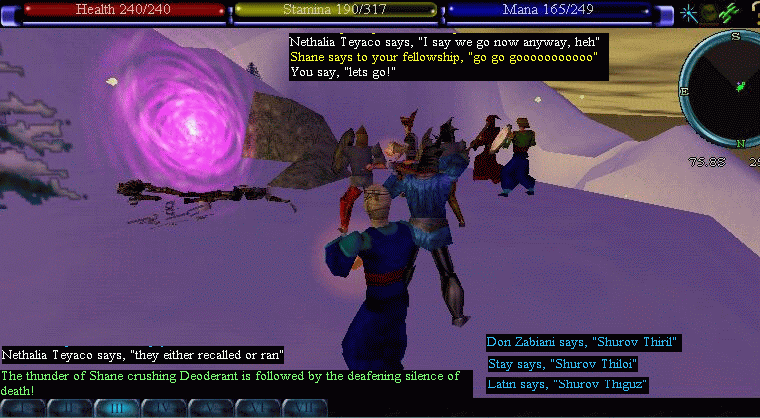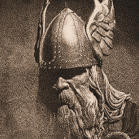Classical Music
Here is my top ten favorite classical music pieces. I'm not a buff by any means, but I do enjoy some good classics every now and then.
1. In the Hall of the Mountain King - Edvard Grieg - Peer Gynt, Suite No. 1, Opus 46 - 1876
The piece is played as the eponymous Peer Gynt, in a dream-like fantasy, enters "the royal hall of the Old Man of the Dovrë (the Mountain King)." The scene's introduction continues: "There is a great crowd of troll courtiers, gnomes and goblins. The Old Man sits on his throne, with crown and sceptre, surrounded by his children and relatives. Peer Gynt stands before him. There is a tremendous uproar in the hall." The lines sung are the first lines in the scene.
"If I were the King of a mountain, and I was entering into my great hall....this is the song I would want played." - Throne
2. Lacrimosa (Requiem) - Wolfgang Amadeus Mozart - Requiem Mass in D Minor (K. 626) - 1791
It is one of the most enigmatic pieces of music ever composed, mostly because of the myths and controversies surrounding it, especially around how much of the piece was completed by Mozart before his death. The autograph manuscript shows the finished and orchestrated introit in Mozart's hand, as well as detailed drafts of the Kyrie and the sequence Dies Irae as far as the first nine bars of "Lacrimosa", and the offertory. It cannot be shown to what extent Süssmayr may have depended on now lost "scraps of paper" for the remainder; he later claimed the Sanctus and Agnus Dei as his own. Walsegg probably intended to pass the Requiem off as his own composition, as he is known to have done with other works. This plan was frustrated by a public benefit performance for Mozart's widow Constanze. A modern contribution to the mythology is Peter Shaffer's 1979 play Amadeus, in which the mysterious messenger with the commission is the masked Antonio Salieri who intends to claim authorship for himself.
3. O Fortuna - Carl Orff - First movement from Carmina Burana - 1935
In 1935–36 O Fortuna was set to music by the German composer Carl Orff for his twenty-four-movement cantata Carmina Burana. The composition appears in numerous films and television commercials and has become a staple in popular culture, setting the mood for dramatic or cataclysmic situations.[1] For instance, it is used to portray the torment of Jim Morrison's drug addiction in the film The Doors.
Good stuff to play before going into pvp - Throne
4. Morning Mood - Edvard Grieg - Peer Gynt Suite No. 1 Opus 23 - 1875
Morning Mood (Norwegian: Morgenstemning; German: Morgenstimmung), sometimes abbreviated to Morning,[1] is a composition belonging to Edvard Grieg's Peer Gynt, Op. 23, written in 1875 as incidental music to Henrik Ibsen's play of the same name, and was also included as the first of four movements in Peer Gynt Suite No. 1, Op. 46. Along with In the Hall of the Mountain King, Morning Mood is one of Grieg's best known works and is often used in films, television commercials, and shows (most notably cartoons)
5. Bolero - Maurice Ravel - Orchestra - 1928
The work had its genesis in a commission from the dancer Ida Rubinstein, who asked Ravel to make an orchestral transcription of six pieces from Isaac Albéniz's set of piano pieces, Iberia. While working on the transcription, Ravel was informed that the movements had already been orchestrated by Spanish conductor Enrique Arbós, and that copyright law prevented any other arrangement from being made. When Arbós heard of this, he said he would happily waive his rights and allow Ravel to orchestrate the pieces. However, Ravel changed his mind and decided initially to orchestrate one of his own previously-written works. He then changed his mind again and decided to write a completely new piece based on the musical form and Spanish dance called bolero. While on vacation at St Jean-de-Luz, Ravel went to the piano and played a melody with one finger to his friend Gustave Samazeuilh, saying "Don't you think this theme has an insistent quality? I'm going to try and repeat it a number of times without any development, gradually increasing the orchestra as best I can." This piece was initially called Fandango, but its title was soon changed to "Boléro".
6. Kanon in D - Johann Pachelbel - Musikalische Ergötzung - abt 1694
Although Pachelbel was renowned in his lifetime for his chamber works (contemporary sources praise his serenades and sonatas), most of them were lost. Only Musikalische Ergötzung, a collection of partitas published during Pachelbel's lifetime, is known, and a few isolated pieces in manuscripts. Canon and Gigue in D major is one of such pieces. A single manuscript copy of it survives, Mus.MS 16481 in the Berlin State Library, which contains two more chamber suites; another copy, previously kept in Hochschule der Künste in Berlin, is now lost.[2] The circumstances of the piece's composition are wholly unknown. One writer hypothesized that the Canon may have been composed for Johann Christoph Bach's wedding, on 23 October 1694, which Pachelbel attended. The music for the occasion was provided by Johann Ambrosius Bach, Pachelbel, and other friends and family members.[3] Johann Christoph Bach, the oldest brother of Johann Sebastian Bach, was a former pupil of Pachelbel.
7. La Primavera - Antonio Lucio Vivaldi - Le Quattro Stagioni (Opus 8, RV 269) 1723
The concertos were first published in 1725 as part of a set of twelve concerti, Vivaldi's Op. 8, entitled Il cimento dell'armonia e dell'inventione (The Contest Between Harmony and Invention). The first four concertos were designated Le quattro stagioni, each being named after a season. Each one is in three movements, with a slow movement between two faster ones. At the time of writing The Four Seasons, the modern solo form of the concerto had not yet been defined (typically a solo instrument and accompanying orchestra). Vivaldi's original arrangement for solo violin with string quartet and basso continuo helped to define the form.
8. Symphony No. 9 in D minor - Ludwig van Beethoven - Opus 125 1824
The Symphony No. 9 in D minor, Op. 125, is the final complete symphony of Ludwig van Beethoven. Completed in 1824, the symphony is one of the best-known works of the Western classical repertoire.[1] Among critics, it is universally considered to be among Beethoven's greatest works, and is considered by some to be the greatest piece of music ever written.[1] It has been adapted for use as the European Anthem.
9. Clarinet concerto in A major (Adagio) - Wolfgang Amadeus Mozart - K. 622 1791
As there is no autograph for this concerto and as it was published posthumously, it is difficult to understand all of Mozart's intentions. The only relic of this concerto written in Mozart's hand is an excerpt of an earlier rendition of the concerto written for basset horn in G. This excerpt is nearly identical to the corresponding section in the published version for A clarinet. Most likely Mozart originally intended the piece to be written for basset horn, as Anton Stadler was also a virtuoso basset horn player, but eventually was convinced the piece would be more effective for clarinet. However, since several notes throughout the piece go beyond the conventional range of the A clarinet, we can presume it was intended to be played on the basset clarinet, a special clarinet championed by Stadler that had a range down to low (written) C, instead of stopping at (written) E as standard clarinets do.
10. Hallelujah - Georg Friederich Handel - Messiah HWV 56, 1741
Handel wrote Messiah for modest vocal and instrumental forces, with optional settings for many of the individual numbers. In the years after his death, the work was adapted for performance on a much larger scale, with giant orchestras and choirs. In other efforts to update it, its orchestration was revised and amplified by (among others) Mozart. In the late 20th and early 21st centuries the trend has been towards authenticity; most contemporary performances show a greater fidelity towards Handel's original intentions, although "big Messiah" productions continue to be mounted. Since a near-complete version was issued on 78 rpm discs in 1928, the work has been recorded many times.
Great for right after a big pvp win - Throne



5 Comments
Recommended Comments